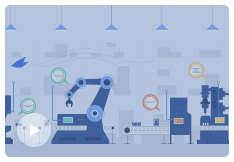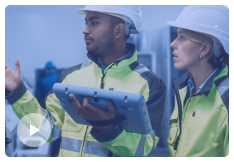
As manufacturers invest in Industry 4.0 technologies, the conversation often leans toward automation, data analytics, and predictive systems. But the real transformation isn’t happening in the tech stack alone—it’s happening on the shop floor.
Connected Manufacturing is reshaping the industry not just through smarter machines, but through smarter collaboration. By linking people, systems, and data into one cohesive ecosystem, this model empowers frontline teams—operators, technicians, and supervisors—to become active participants in real-time decision-making and continuous improvement.
In a time when manufacturers are expected to do more with less, and where agility is critical, the frontline can no longer be an afterthought in digital transformation. They are the heartbeat of production—and their engagement is the difference between adoption and impact.
From Reactive to Proactive: Rethinking Frontline Enablement
As manufacturers adopt digital tools, a key challenge emerges: the frontline often lacks timely access to the data being captured. Many manufacturers today are collecting more data than ever—via sensors, MES platforms, and machine learning algorithms. But too often, that data gets trapped in siloed systems or delayed reports. Frontline workers are expected to hit targets without timely access to the insights they need to make informed decisions on the shop floor.
This disconnect creates a reactive environment where issues are addressed after the fact, not prevented. It also limits the role of the frontline to execution, rather than strategic contribution.
Connected Manufacturing closes this gap. It creates a digital feedback loop where performance data is visible, contextualized, and actionable—right where the work happens. And it does more than inform operators; it invites them into the improvement process—something increasingly critical as the workforce evolves and newer operators step into roles once held by decades of experience.
Frontline-First Digital Transformation: What It Looks Like
Digital transformation in manufacturing falls short when it overlooks the people who power production. Successful implementation requires more than a new tool—it demands a shift in mindset, processes, and culture.
Here’s what a practical, frontline-first approach looks like on the shop floor:
- Intuitive interfaces (tablets, kiosks) for fast interaction on the shop floor
- Operator-driven contextualization of downtime and performance events
- Automated alerts when performance drops, empowering immediate response
- Shared, role-based dashboards with plant-wide transparency
- Continuous feedback loops, not just annual reviews
AI-powered tools—especially those built on generative models—can support decision-making here, but only when fueled by high-quality, contextual data from the frontline itself.
This environment doesn’t replace operator experience—it amplifies it. But providing teams with the right tools is only part of the equation; it’s how that data is delivered, understood, and used on the floor that truly drives lasting change.
Real-Time Visibility That Drives Ownership
Real-time visibility in manufacturing is essential—but only if the data is accessible, actionable, and tied to daily work. Tools like Raven give frontline teams the ability to track performance, flag issues, and act on problems as they arise.
But true impact comes when data is not only visible, but meaningful. When operators understand how their actions influence uptime, throughput, or quality in the moment, they shift from passive participants to active problem-solvers. They don’t just collect data—they contribute to it.
By adding human context to machine data, identifying patterns, and surfacing insights, frontline teams make the data smarter—and the decisions better. That’s where cultural transformation begins. Instead of working for the system, teams start working with it, and co-owning the outcomes.
From Ownership to Engagement: The Role of Industrial Gamification
Building on that sense of ownership, the next step is engagement. Industrial gamification—using simple, motivating tools like feedback, recognition, and shared goals—helps encourage the right behaviors. Think of it as turning daily performance into something more visible and rewarding, where teams can see their progress and feel proud of their impact.
In practice, Connected Manufacturing environments—especially those using platforms like Raven, a real-time OEE and continuous improvement platform—bring industrial gamification to life through features like:
- Live shift scoreboards that show team performance in real time
- Recognition tools that celebrate contributions to uptime or quality
- Mini-challenges that reward proactive problem-solving or process improvement
- Interactive dashboards that visualize progress against KPIs and make performance easy to understand at a glance
Gamification in manufacturing isn’t a gimmick—it’s grounded in psychology. By making performance personal and measurable, it builds a sense of momentum and shared ownership across shifts and teams.
Enabling Collaboration on the Shop Floor
Once teams are engaged and have real-time visibility into their performance, the next opportunity lies in enabling deeper cross-functional collaboration. Traditionally, manufacturing operations have been segmented—with data moving vertically from shop floor to management, often delayed and stripped of context. This approach slows response times and limits collaboration.
Connected Manufacturing brings teams together on the shop floor, with production, maintenance, engineering, and quality all working from the same source of real-time information and insight.
This enables:
- Faster root cause analysis
- Smoother shift transitions
- More effective daily huddles
- Collaborative troubleshooting
With frontline input flowing directly into digital systems, teams respond in real time—not from reports, but from shared context. True collaboration is sustained not just by access to data, but by systems that equip the people closest to the work.
Operational Excellence Is Human-Driven
Operational excellence starts with people. When frontline teams are engaged and contributing, operational improvements don’t just happen faster—they happen smarter. That’s where the business value of Connected Manufacturing becomes clear.
As demands grow and seasoned operators retire, manufacturers need more than automation. Connected Manufacturing turns data into action—empowering even less experienced workers to make confident, real-time decisions and adapt with agility.
With tools like Raven, teams gain real-time insight, add context to production events, and act on issues as they happen—creating a more agile, aligned, and resilient operation.
The future of manufacturing is connected—and it’s powered by the people who keep it moving.
Learn how Raven helps manufacturers close the loop between data and frontline action.







